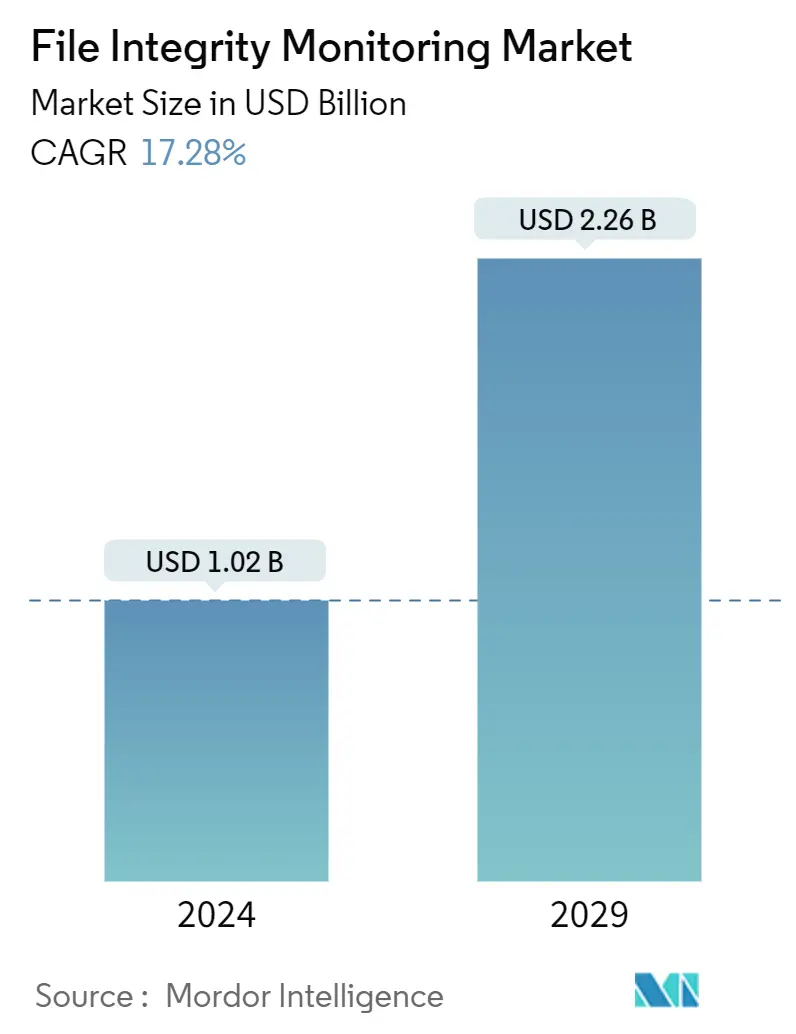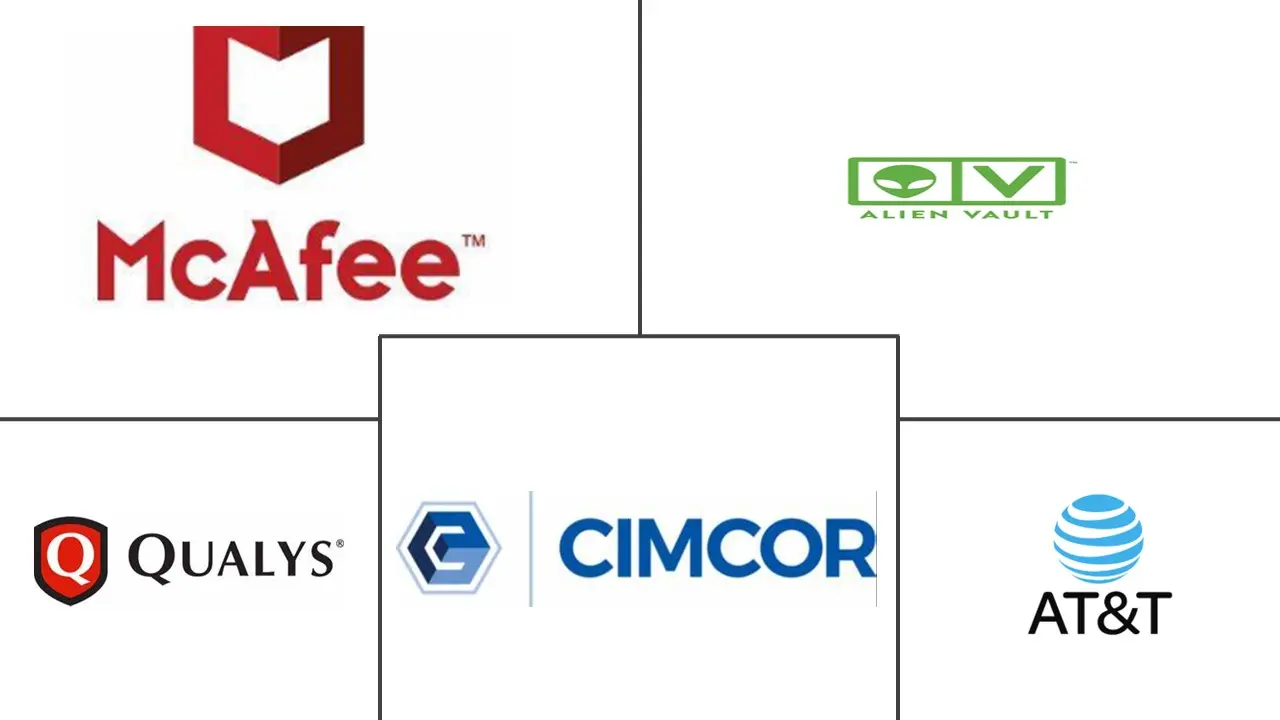Market Size of File Integrity Monitoring Industry

| Study Period | 2019-2029 |
| Market Size (2024) | USD 1.02 Billion |
| Market Size (2029) | USD 2.26 Billion |
| CAGR (2024 - 2029) | 17.28 % |
| Fastest Growing Market | Asia-Pacific |
| Largest Market | North America |
Major Players
*Disclaimer: Major Players sorted in no particular order |
File Integrity Monitoring Market Analysis
The File Integrity Monitoring Market size is estimated at USD 1.02 billion in 2024, and is expected to reach USD 2.26 billion by 2029, growing at a CAGR of 17.28% during the forecast period (2024-2029).
The file integrity monitoring market is a service that enables organizations to test and check operating system (OS), database, and application software files to determine whether or not they have been tampered with or corrupted documents, photos, videos, and files in a secure manner. Organizations adopt these technologies to help employees avoid using consumer-based file-sharing applications and software to store, access, and manage to ensure data security.
- For instance, enterprises' workstation dominantly uses Windows, Mac OS, and Linux OS. In contrast, their employees utilize mobile devices like tablets and smartphones, with Android and iOS as the dominant operating systems. Due to the widespread adoption of cloud services and an increasing number of active directory users, admins find it difficult to manage privileges and rights granted to the people inside the organization. This has led to an increased vulnerability, which could be disastrous for the organization.
- File integrity monitoring eases the admin process and has been a critical tool in combating cyber threats organizations have recently faced. File integrity monitoring solution monitors the activity of the shared files and is also responsible for timely alerting the admin to minimize the threats.
- The key issue that the file integrity monitoring market resolves is privilege abuses. Privilege abuse is when the policies of the user within the network are not updated, due to which the user's credentials are used to access the files and then make changes to them.
- The landscape of file monitoring and integrity management solution has been changing rapidly. Earlier, the systems admin used to manually grant access and check for vulnerabilities. Still, as the number of events increased, it became impossible for the admins to identify the treats. This gave rise to Netwrix, Lepide, and Dell solutions, which offered standalone solutions for the market. However, these solutions limited the number of users and managed many events.
- The antivirus providers, like Kaspersky and McAfee, realized the importance of this additional layer of security and integrated the solution into their antivirus solutions. However, companies like IBM and SolarWinds have solutions that meet large enterprises' requirements and have advanced methodologies to identify false positives to declutter the notifications sent to the admins.
- During the outbreak of COVID-19, cyber threats were on the rise in numerous countries. For instance, the Australian Cyber Security Centre (ACSC) announced protecting itself from cyberattacks amid the pandemic. Various countries further enhanced their efforts to increase file integrity monitoring systems.
- Cybersecurity became a top priority during the global COVID-19 pandemic. There was an increasing dependence on digital technologies to keep the file integrity monitoring process running. Moreover, according to the US Bureau of Labor Statistics (BLS), from 2022 to 2032, information security analyst employment is expected to grow by 32%, substantially faster than the average for all occupations.
File Integrity Monitoring Industry Segmentation
The file integrity monitoring market is a service that enables organizations to test and check operating system (OS), database, and application software files to determine whether or not they have been tampered with or corrupted documents, photos, videos, and files in a secure manner. Large enterprises that utilize file monitoring and integrity solution use it to add flexibility to their access policies that govern the organization's accessibility. The capabilities of the file monitoring and integrity management solution include security features, like authentication and tracking, to protect enterprise data.
The file integrity monitoring market is segmented by organization size (small and medium enterprises, large enterprises), deployment type (on-premises, cloud), installation mode (agent-based, cloud), end-user industry (retail, BFSI, hospitality, healthcare, government, entertainment), and geography (North America, Europe, Asia-Pacific Latin America, Middle East & Africa). The market sizes and forecasts are provided in terms of value (USD) for all the above segments.
| By Organization Size | |
| Small and Medium Enterprises | |
| Large Enterprises |
| By Deployment Type | |
| On-Premise | |
| Cloud |
| By Installation Mode | |
| Agent-Based | |
| Cloud |
| By End-user Industry | |
| Retail | |
| BFSI | |
| Hospitality | |
| Healthcare | |
| Government | |
| Entertainment | |
| Other End-user Industries |
| Geography | |
| North America | |
| Europe | |
| Asia-Pacific | |
| Latin America | |
| Middle East & Africa |
File Integrity Monitoring Market Size Summary
The file integrity monitoring market is experiencing significant growth, driven by the increasing need for organizations to secure their operating systems, databases, and application software from tampering and corruption. This market is characterized by the adoption of technologies that help prevent the use of consumer-based file-sharing applications, thereby enhancing data security. The rise in cyber threats, particularly during the COVID-19 pandemic, has underscored the importance of these solutions, as organizations faced heightened vulnerabilities. The market is evolving with advancements in technology, where traditional manual processes are being replaced by automated solutions from key players like Netwrix, Lepide, and Dell. These solutions are now integrated into broader security offerings by antivirus providers such as Kaspersky and McAfee, as well as enterprise-focused solutions from companies like IBM and SolarWinds, which cater to large organizations with sophisticated needs.
The demand for file integrity monitoring solutions is particularly strong in the BFSI sector, which is highly susceptible to cyberattacks due to the sensitive nature of financial data. The prevalence of active directory-based hacking and ransomware attacks has further driven the need for robust monitoring systems. Regulatory compliance and the protection of critical customer data are paramount, prompting banking institutions to adopt advanced technologies. The Asia-Pacific region presents lucrative opportunities for market expansion, driven by the shift to hybrid cloud environments and the need for enhanced security measures. The fragmented market sees major players like AT&T, McAfee LLC, and Qualys Inc. focusing on product diversification and strategic partnerships to strengthen their market presence. Recent collaborations, such as those between LogRhythm and Cimcor, and the introduction of platforms like Qualys' GovCloud, highlight the ongoing innovation and commitment to addressing modern cyber threats.
File Integrity Monitoring Market Size - Table of Contents
-
1. MARKET INSIGHTS
-
1.1 Market Overview
-
1.2 Industry Attractiveness - Porter's Five Forces Analysis
-
1.2.1 Threat of New Entrants
-
1.2.2 Bargaining Power of Buyers/Consumers
-
1.2.3 Bargaining Power of Suppliers
-
1.2.4 Threat of Substitute Products
-
1.2.5 Intensity of Competitive Rivalry
-
-
1.3 Industry Value Chain Analysis
-
1.4 Assessment of COVID-19 Impact on the File Integrity Monitoring Market
-
-
2. MARKET SEGMENTATION
-
2.1 By Organization Size
-
2.1.1 Small and Medium Enterprises
-
2.1.2 Large Enterprises
-
-
2.2 By Deployment Type
-
2.2.1 On-Premise
-
2.2.2 Cloud
-
-
2.3 By Installation Mode
-
2.3.1 Agent-Based
-
2.3.2 Cloud
-
-
2.4 By End-user Industry
-
2.4.1 Retail
-
2.4.2 BFSI
-
2.4.3 Hospitality
-
2.4.4 Healthcare
-
2.4.5 Government
-
2.4.6 Entertainment
-
2.4.7 Other End-user Industries
-
-
2.5 Geography
-
2.5.1 North America
-
2.5.2 Europe
-
2.5.3 Asia-Pacific
-
2.5.4 Latin America
-
2.5.5 Middle East & Africa
-
-
File Integrity Monitoring Market Size FAQs
How big is the File Integrity Monitoring Market?
The File Integrity Monitoring Market size is expected to reach USD 1.02 billion in 2024 and grow at a CAGR of 17.28% to reach USD 2.26 billion by 2029.
What is the current File Integrity Monitoring Market size?
In 2024, the File Integrity Monitoring Market size is expected to reach USD 1.02 billion.

